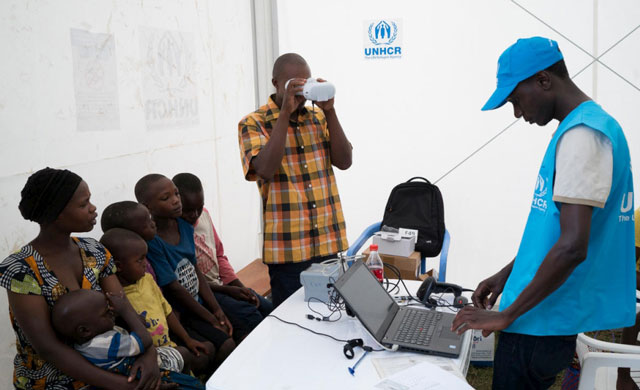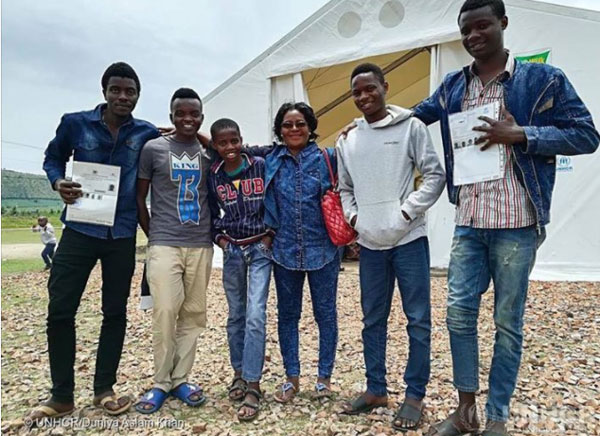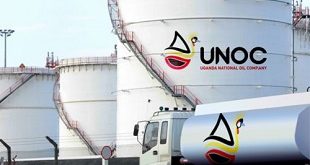
Isingiro, Uganda | THE INDEPENDENT | Over 6,900 refugees have received new attestation forms and ration cards at the end of the first phase of a countrywide biometric verification exercise that started on March 1, 2018 in the Oruchinga refugee settlement in Uganda’s South-West region.
UNHCR, the UN Refugee Agency, is supporting the Government of Uganda in a countrywide biometric data verification to fix any discrepancies in refugee data. The massive exercise is to be rolled out across the country.
In a statement released on March 10, UNHCR revealed it had captured fingerprints, iris scans and photos of 6,972 refugees in Oruchinga refugee settlement during the week-long exercise. Every refugee family who was verified biometrically has now received a proof of verification form and new ration card.
The World Food Programme (WFP) then distributed food to a total of 6,710 refugees from 6 to 8 March at the settlement after biometrically verifying their identities. Oruchinga refugee settlement is home to thousands of Congolese refugees.
The data verification exercise is scheduled to be completed by September 2018 – including introduction of biometric checks at 180 food distribution sites. UNHCR, working with partners, will be deploying more than 400 additional staff, to over 30 locations covering more than 800 kilometers.
This is UNHCR’s biggest-ever verification exercise in Africa. The biometric teams will now proceed to Nakivale, where the verification will start on Wednesday 14, March.

Uganda’s request
Following reports of inflated figures of refugees in Ugandan camps, Prime Minster Dr. Ruhakana Rugunda requested for the biometric verification of refugees.
UNHCR mobilized significant human and financial resources to facilitate the government to verify the refugee population using UNHCR’s biometric system while WFP also set up infrastructure.
Douglas Asiimwe, the Officer in Charge of Refugee Protection in the Office of the Prime Minister (OPM) extended his appreciation to the teams for the successful completion of refugee verification in Oruchinga.
He said, “Enhanced biometric verification system that captures iris and ten fingerprints will strengthen credibility and accuracy of the existing refugee data which will ensure that refugees are accurately reflected in the registration system.”
UNHCR Representative in Uganda, Bornwell Kantande said that, “Using biometric identification and verification systems for large scale humanitarian operations is extremely important. It allows us to check that a refugee is not registered more than once and it will also ensure that humanitarian resources and services are being provided to refugees in efficient manner.”
WFP Uganda Country Director, El Khidir Daloum added: “WFP looks forward to working closely with the Office of the Prime Minister (OPM) and UNHCR over the coming months to make this exercise a success and deliver assistance efficiently to the people we serve. This biometric system will ensure we are giving the right people the right assistance.”
Uganda praised on refeugees
Uganda provides protection to more than one million refugees, and maintains an open-door policy for people fleeing conflict and persecution.
The government retains the responsibility for the refugee response in Uganda, including registration and documentation of new arrivals.
The verification exercise will ensure that refugees and asylum-seekers are accurately reflected in the registration system and assist the Government of Uganda to enhance the accuracy of data. This will make certain that resources and services provided by UNHCR and its partners reach the intended recipients.
Uganda’s asylum policy framework is considered to be one of the most progressive in the world, providing refugees with plots of land, integrated with local host communities, on which to build new homes and to grow crops. Refugees in Uganda share public services, including healthcare and education, with Ugandan nationals, who have consistently welcomed refugees with generosity and hospitality.
Refugees are also given the right to work and start businesses, as well as freedom of movement. This means the refugee population in Uganda is spread throughout various refugee settlements and urban areas throughout the country, adding to the logistical complexity of the verification exercise.
Uganda has seen the size of its refugee population rapidly increase in recent years as it continues to welcome new arrivals from three ongoing emergencies in South Sudan, the Democratic Republic of the Congo (DRC) and Burundi. Already in the first two months of 2018, the country has become home to more than 50,000 new arrivals, predominantly fleeing violence in eastern DRC arriving on boats through Lake Albert.
 The Independent Uganda: You get the Truth we Pay the Price
The Independent Uganda: You get the Truth we Pay the Price


